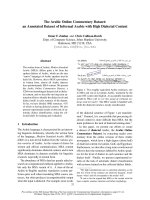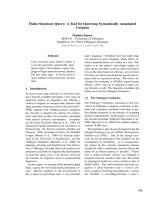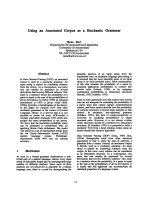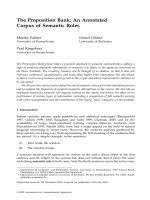Annotated bibliography
Bạn đang xem bản rút gọn của tài liệu. Xem và tải ngay bản đầy đủ của tài liệu tại đây (145.78 KB, 26 trang )
SIX ANNOTATED BIBLIOGRAPHY
183
SIX
Annotated bibliography
This section is a guided tour to around 50 or so key books written
about various aspects of e-business.
Mastering the Digital Market Place: Practical
Strategies for Competitiveness in the E-business
Douglas F. Aldrich • John Wiley, 2000
In the digital economy, argues Aldrich, there are two key measures
of value: time (as in how much time your product or service will save
the customer) and content (information, knowledge, or services that
provide added value to the customer). He goes on to outline a new
business model which he calls the Digital Value Network (DVN), a
community of electronically linked business partners that work
together to produce value for the customer as the customer defines
it, and offers strategies for creating and sustaining it. An intriguing
business model, and Aldrich makes a compelling case for it becom-
ing a blueprint for success in the digital revolution.
The Last Days of the Giants?
Robert Baldock • John Wiley, 2000
Robert Baldock sees major problems ahead for any of us working in
those organizations that have come to believe that their sheer size
will protect them from the unpredictability of the next few years. ‘The
environment in which the culture of ‘bigness’ blossomed is fast disap-
pearing in many industries,’ he tells us. However, the question mark
in the title of Baldock’s book is significant – the corporate giants of
late 20th century may be in serious trouble but he believes they can
GURUS ON E
-
BUSINESS
184
survive in the intensely competitive environment of the 21st if they
radically alter the way they do things. The optimal 21st century organ-
ization, says Baldock, will be a buyer-driven virtual enterprise that
satisfies consumer intentions.
The Age of E-tail: Conquering the New World
of Electronic Shopping
Alex Birch, Philipp Gerbert, & Dirk Schneider • Capstone, 2000
In The Age of E-tail, the authors explore 12 key themes that are rele-
vant to any business that is considering going down the e-commerce
route. As well as exploring these themes in depth, the book contains
some nice touches. Each chapter contains a ‘searchlight’ summary
of key points as well as a list of websites for the companies highlighted
by the authors as examples of good and bad practice. Throughout
the book, there are useful tips and wrinkles for the e-tail novice. More
crucially, the authors set out a coherent and credible approach to e-
tail which speaks as much to the long established bricks and mortar
business as it does to the fresh-faced start-up proposition. As a guide
to how to enter successfully the world of electronic shopping, it hasn’t
yet been bettered.
The Meme Machine
Susan Blackmore • Oxford University Press, 1999
Once humans learned to receive, copy and retransmit memes – in
essence a captivating idea, behaviour, or skill that can be transferred
from one person to another by imitation – the rest, says Blackmore,
is a foregone conclusion. Memetic competition shapes our minds and
culture, just as natural selection has shaped our physical evolution.
But why should this matter to us and the organizations we work for?
Well for a start, it explains why the sexual adventures of an errant
senior manager would grip the corporate imagination more than the
latest set of financial figures. Blackmore explores her subject with great
panache. Some readers who like to explore both sides of an argu-
SIX ANNOTATED BIBLIOGRAPHY
185
ment before making up their own minds may find her sure-footed
advocacy a little overpowering, but for the rest of us The Meme Machine
is a riveting and provocative read.
The Electronic B@zaar
Robin Bloor • Nicholas Brealey, 2000
Bloor’s mix of leading-edge IT analysis, historical perspective and
a sound grasp of economic principles makes for an informative and
entertaining account of the new economic landscape. The Electronic
B@zaar occasionally reads as though it has been put through some
kind of Tom Peters-style writer software, but nonetheless the book
is a compelling call-to-arms for anybody seeking practical tips
about making the transition from bricks-and-mortar to successful
e-business.
Knowledge Capitalism
Alan Burton-Jones • Oxford University Press, 1999
Burton-Jones marshals an impressive range of evidence in this
closely argued exploration of how the shift to a knowledge-based
economy is redefining the shape and nature of organizations. He also
describes the emergence of a new breed of capitalist, one depend-
ent on knowledge rather than physical resources. There are plenty
of easier reads about the knowledge economy on the market, but those
looking for substance rather than eye-catching glibness will be
pleased to find in Knowledge Capitalism a book that provides frequent
moments of insight without compromising gravitas.
E-business and E-commerce Management
Dave Chaffey • FT Prentice Hall, 2003
The second edition of E-Business and E-Commerce Management builds
on the excellent coverage and balanced approach of the first edition.
GURUS ON E
-
BUSINESS
186
Drawing on perspectives and models from disciplines as diverse as
information systems, strategy, marketing, operations and human
resources management. This new edition also features increased cover-
age of legal and regulatory issues, not-for-profit organizations and
a wider range of international case studies.
A comprehensive assessment of the management issues faced in imple-
menting e-business solutions, this book is suitable for students or
practitioners of e-business, e-commerce or e-marketing at any level.
Each chapter contains management issues, activities and answers,
case studies, questions for debate, self-assessment exercises, discus-
sion, essay and exam questions, further reading, web links and more.
Built to Last
James Collins and Jerry Porras • HarperBusiness, 1994
When Built to Last appeared in 1994, it was the product of a six year
investigation by James Collins and Jerry Porras, both Stanford
professors at the time, which set out to uncover the underlying prin-
ciples that could yield enduring, great companies. For the book, they
examined 18 companies that had significantly outperformed the general
stock market over a number of decades. The companies looked at
included Disney, General Electric, Hewlett-Packard, IBM and Wal-
Mart. So what’s this got to do with e-business? Well, implicit on every
page of Built to Last is a simple question – why would a company settle
for creating something mediocre that does little more than make money,
when it could create something outstanding that makes a lasting contri-
bution as well? At a time when it seems the lifespan of some dot.com
companies can be measured in weeks or months rather than decades,
this question strikes at the heart of business and life in the New
Economy. Let’s hope that founders of New Economy businesses come
to realize that it is better to concentrate primarily on building an organ-
ization rather than on hitting a market just right with a visionary
product idea and riding the growth curve of an attractive product
cycle. Let’s also hope that the primary output of their efforts is the
SIX ANNOTATED BIBLIOGRAPHY
187
tangible implementation of a great and sustainable idea and that their
greatest creation is the company itself and what it stands for.
The Weightless World
Diane Coyle • Capstone, 1997
In The Weightless World, Diane Coyle, who is economics editor at The
Independent, maps out the economic and social landscape in a world
increasingly transformed by the digital revolution, not to mention glob-
alism and the disappearance of many of the old securities. For Coyle,
weightlessness is a ‘symbol of the economic effects of the clusters of
advances in information and communication technology,’ and the finan-
cial markets ‘the ultimate embodiment of weightlessness, or in other
words the intangibility of an increasing proportion of modern
economies’. What gives the concept particular potency is the manner
in which technological change interacts with other fundamental
changes like demographic and social trends and the grand sweep of
social history, creating, in Coyle’s word’s, ‘the age of insecurity’.
Blur
Stan Davis and Christopher Meyer • Addison-Wesley, 1998
The authors, who are both based at the Ernst & Young Center for
Business Innovation in Boston, maintain that ‘connectivity, speed, and
the growth of intangible value’ have catapulted business into a period
of unprecedented transition that demands immediate and creative
attention. These three elements in combination, say Davis and Meyer,
‘are blurring the rules and redefining our businesses and our lives.
They are destroying solutions, such as mass production, segmented
pricing, and standardized jobs, that worked for the relatively slow,
unconnected industrial world’.
GURUS ON E
-
BUSINESS
188
Future Wealth
Stan Davis and Christopher Meyer
Harvard Business School Press, 2000
In Future Wealth – described as the companion volume to Potted Biog-
raphys’ best-selling book Blur – Davis and Meyer identify three major
consequences of the newly connected economy: risk as opportunity,
not only as threat; the growing efficiency of financial markets for human
capital; and the need for new forms of social capital. They go on to
explain why they think we are headed toward a new stage of
economic development in which ‘human and intellectual capital [is]
the most highly valued resource’.
In the Company of Giants
Rama Dev Jager & Rafael Ortiz • McGraw-Hill, 1997
Described by Potted Biographys as a set of ‘candid conversations with
the visionaries of the digital world,’ the book comprises transcripts
of 15 interviews, each one preceded by a brief pen picture of the inter-
viewee. Those featured include Bill Gates, Andy Grove, Bill Hewlett
and Michael Dell, and so the book does live up to its title. Although
there are some useful tidbits and quotable responses to questions,
the book also serves to demonstrate how much things have changed
in the years since In the Company of Giants was published.
Post-Capitalistic Society
Peter Drucker • HarperCollins, 1993
An early picture of e-business which has held up extremely well over
the intervening years. Tom Peters may be the most famous living
management guru, but Drucker is probably the most respected and
insightful.
SIX ANNOTATED BIBLIOGRAPHY
189
StrikingitRich.com
Jaclyn Easton • McGraw-Hill, 1999
Sub-titled profiles of 23 incredibly successful companies you’ve prob-
ably never heard of, Jaclyn Easton’s rigorously researched and
extremely readable book proves that websites don’t have to be high
profile extravaganzas to make serious money. The sites demonstrate
that it is perfectly possible for a website to achieve a profit quickly if
an idea is well conceived and executed and if start-up costs are managed
tightly.
Entrepreneurship and the Wired Life:
Work in the Wake of Careers
Fernando Flores & John Gray • Demos, 2000
The career, as an institution, is in unavoidable decline according to
this fascinating pamphlet from independent UK think-tank Demos.
The authors describe two work patterns – the Wired and the Entre-
preneurial – which might replace the traditional career work pattern.
In a nutshell, the Wired life/work pattern replaces the lifelong iden-
tity of the career with a series of ‘brief habits’, at the heart of which
is spontaneity rather than continuity of projects and relationships.
With the Entrepreneurial life/work pattern, Flores and Gray widen
out the narrow economic definition of entrepreneurship to include
all manner of activities which initiate meaningful change in a context
of shared responsibility. This could be in commerce, service or in society
in general. The authors go on to examine these new forms of working
life in some detail and consider the implications for individuals and
communities. They conclude that core institutions – from education
to pensions – need restructuring to support these changes. At only
48 pages long, Entrepreneurship and the Wired Life is that rare phenom-
enon – a business book that could usefully have been double the length.
GURUS ON E
-
BUSINESS
190
The Tipping Point: How Little Things Can
Make a Big Difference
Malcolm Gladwell • Little Brown, 2000
Why do some minority tastes remain strictly minority, while others
extend into the mainstream? The Tipping Point is a well written and
racy exploration of what lies behind the point when a small fad acquires
critical mass and takes off. It’s very readable but the central idea isn’t
really enough to sustain a whole book – no surprise then to discover
that it began its life as a long article in New Yorker magazine.
Net Gain
John Hagel III & Arthur G. Armstrong
Harvard Business School Press, 1997
Well-written and insightful view of the e-business focusing on how
virtual communities can expand markets. Highly recommended by
Kevin Kelly in his bibliography at the back of New Rules for the New
Economy.
Online Consumer Psychology: Understanding and
Influencing Consumer Behavior in the Virtual World
Curtis P Haugtvedt et al. • Lawrence Erlbaum Associates, Inc, 2005
Online Consumer Psychology addresses many of the issues created
by the internet and goes beyond the topic of advertising and the web
to include topics such as customization, site design, word of mouth
processes, and the study of consumer decision making while online.
The theories and research methods help provide greater insight into
the processes underlying consumer behavior in online environ-
ments. Broken into six sections, this book focuses on the advantages
of the internet’s ability to bring like-minded individuals from around
the room into one forum; examines issues related to advertising, specif-
ically click-through rates and advertising content placed within
SIX ANNOTATED BIBLIOGRAPHY
191
gaming online and wireless networks; provides readers with reasons
why consumers customize products and the benefits of customiza-
tion; discusses the psychological effects of site design; asks the question
of whether the internet empowers consumers to make better deci-
sions; and discusses research tools that can be used online.
The Elephant and the Flea
Charles Handy • Hutchinson, 2001
In this book, self-styled social philosopher Handy explores the busi-
ness world of the 21st century which he claims ‘will be a world of
fleas and elephants, of large conglomerates and small individual enti-
ties, of large political and economic blocs and small countries’. The
smart thing, it seems, is to be the flea on the back of the elephant
because a flea can be global as easily as one of the elephants but can
more easily be swept away. Elephants are a guarantee of continuity
but fleas provide the innovation. A fascinating premise, outlined lucidly
by Handy.
The New Century
Eric Hobsbawm • Little Brown, 2000
In which the late pre-eminent historian (you won’t find a better account
of the twentieth century than his Age of Extremes) offers his analy-
sis of the current state of the world. Although the scope of this book
goes much wider than the e-business, there’s one chapter in partic-
ular – entitled The Global Village – that offers a lucid, cool-headed,
and reasoned assessment of the global economy. It’s a much needed
antidote to the starry-eyed hyperbole that seems to dominate the glob-
alization debate.
GURUS ON E
-
BUSINESS
192
On the Edge
Will Hutton and Anthony Giddens • Jonathan Cape, 2000
On the Edge draws together ten original contributions by leading
thinkers like Paul Volcker, Manuel Castells, Arlie Russell Hochschild
and George Soros. The overall conclusion seems to be that global
capitalism does have huge potential for good but is just as likely to
create a set of consequences that most of us would rather avoid. Co-
author and Industrial Society boss Will Hutton describes global
capitalism as ‘precarious and potentially dangerous’. An important
book that takes a clear-eyed view of its subject.
Starting and Running a Business on the Internet
Tim Ireland • Take That Ltd, 2000
Coming in at just 109 pages and at a quarter of the cost of similar
books, Starting and Running a Business on the Internet is an admirably
concise and accessible guide for those wanting to know the practi-
cal steps involved in setting up a successful internet business, from
first conception through to promoting the site. A cautionary note,
though.
Ireland’s particular strength rests in his knowledge of the mechanics
of setting up a new internet business – from acquiring a domain name,
through to ‘going live’ and taking orders from around the world. He
does not set out to provide a comprehensive guide to the overall busi-
ness start-up process and so readers will find nothing on raising capital,
hiring staff, business planning et al. These reservations aside, this book
is a useful vade mecum for the would-be internet entrepreneur.









